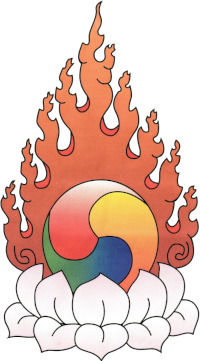We have been working for along time on a variety of topics based on the lamrim, Odyssey to Freedom. Now we have come to the point of the fifth Paramita, the Paramita of Meditation, which is mainly concentrated meditation.
We have two parallel programs running on this topic. One is the course in Ann Arbor on Tuesdays, based on Chapter eight of the Bodhisattva’s Way of Life, the longest chapter in the text. In addition, every Thursday in New York, I will teach the meditation chapter of Tsongkhapa’s bigger lamrim, the Lamrim Chenmo, for the Odyssey to Freedom. Both are on the same subject, but based on different texts.
When finished, this will be one of the most detailed, comprehensive, and complete meditation courses ever given in the United States. We already have been doing a lot of meditation activities throughout these teachings, but we don’t usually call them meditation. The combination of shamatha teachings on the basis of lamrim and teachings on the meditation chapter of the Bodhisattvacharyavatara is going to be a wonderful teaching on meditation, I think, because we’re allowed the time, and the sources are extremely rich. This course is not going to be finished in the regular course period of eight weeks, but hopefully we can finish by the end of the year.
Concentrated Meditation
Concentrated meditation is called, shamatha, in sanskrit. The word in Tibetan is zhi nay. I do not know what shamatha really means, because I don’t know sanskrit. But the word is ‘zhi-nay‘ in Tibetan has a specific meaning: “zhi,” means ‘pacified, peace,’ and “ne” is ‘remains.’ So, zhi-nay is about pacifying all difficulties, obstacles and imbalances within your mind and reaching, maintaining and remaining in a state of peace, mental quiescence.
I don’t think the word, ‘meditation,’ conveys all that. It may give you an idea of being at peace and concentrating, but does not really convey bringing yourself to peace in the sense of over coming and pacifying all obstacles, bothers and worries, all those pressures. There are many words in Tibetan that can be translated as meditation, but among those what we are talking about today is zhi-nay.
Balancing
Another word in Tibetan important in this context is ‘nyam par shak par‘ or, ‘nyam shak.’ Translated directly it says ‘equalizing and remaining.’ Again, I don’t think it means equalizing, but rather balancing the mind. Normally, we have too much struggle, too much push and pull in our mind. For economic or social reasons, for the sake of happiness, name or fame or whatever, we struggle a lot. The word ‘nyam shak‘ here means balancing between too much obsession on the one side and too much hatred on the other side. By meditation we try to balance this and make our mind stable, which means not be swept away by the force of hatred, nor be sucked in by the force of obsession. We try to be balanced in between and maintain the mind at that level.
The learning part of Buddhism will not end until you become enlightened. The working part of it—helping other beings—is never going to end until every sentient being is fully enlightened, so it is a bottomless ocean. In the meantime, it is great we have this, and you cannot do anything better than practice it, so be very happy about it.
~ Gelek Rimpoche, GOM Transcript, 2005, p. 6


